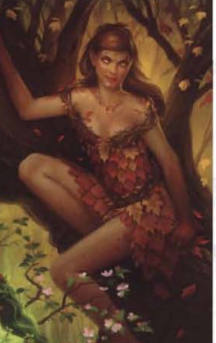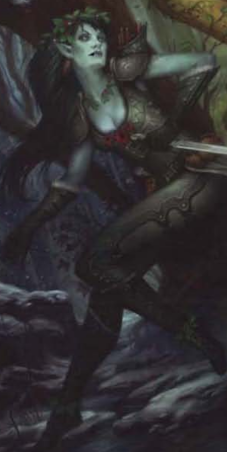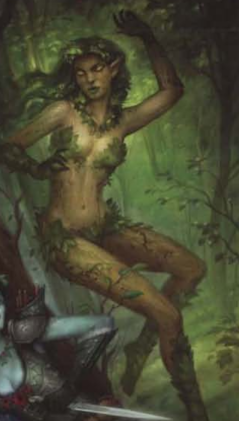Let's Read the 4e Monster Manual 3: Nymph
This post is part of a series! Click here to see the others.
Nymphs have been in the game since the beginning, and they were always one of its many, many “seductress” monsters. The only reason I can think for there being so many of them is that Gygax had issues.
The Lore
In Fourth Edition, Nymphs are fey descended from some of the oldest primal spirits: the Sisters of the Four Seasons, and the Brothers of the Four Winds. Thus they combine their mothers’ beauty with their fathers’ impulsive and fickle personality.
After the Dawn War ended and the Four Seasons took upon themselves the work of maintaining the world’s natural cycles, the nymphs withdrew into the Feywild and spent a long time living there in harmony with nature. However, they’re not content with just staying quiet forever, so they eventually began to range further afield in search of fun.
Nymphs just love mortals. They make such wonderful toys, you see. It’s very easy to convince them to do stuff, and to swear eternal loyalty and love. Toys sometimes break, but that’s just how things are.
Nymphs are divided into subtypes corresponding to the four seasons, each with a different basic personality but sharing the same disdain for mortals. There’s also a fifth type that explains where dryads come from.
The Monsters
Nymphs are Medium Fey Humanoids with Low Light Vision and Forest Walk (meaning they ignore forest-themed difficult terrain). All of their other abilities vary per stat block.
Spring Nymph

Spring nymphs are always seeing new life appear everywhere to replace the old. They have power over flowers, and adorn themselves with them. They are the most childish and romantic of the bunch, so they enjoy seducing mortals and playing mind games with them to get those mortals to chase her and to fight each other for her favor. Spring nymphs will often ensure the prettiest mortal survives these contests, and will then permanently dominate them through constant exposure to the nymph’s psychotropic scent.
Spring Nymphs are Level 5 Controllers with 63 HP and Speed 6. Their powers are all seduction and flower-themed, making them some of the most stereotypical nymphs.
They have a Charmed Defense passive that gives them +3 to all defenses while adjacent to a creature dominated by them. Their basic melee attack is Passion’s Kiss, which targets Will, does low psychic damage, and dazes (save ends). Their basic ranged attack is Song of Spring, which is similar but does a bit more damage and slows instead of dazing.
When she doesn’t have anyone dominated, the spring nymph can use Floral Perfume to rectify this situation. This is a ranged attack vs. Will that must target a dazed or slowed creature, and on a hit pulls the target 3 squares and dominates them (save ends).
Finally, once per encounter, the nymph can use Cloud of Blossoms, a ranged area attack that targets non-dominated enemies, attacks Will, and slows on a hit (save ends). After the first failed save, the target becomes unconscious instead. So this is more of an emergency escape hatch than an opening strike.
When building an encounter with spring nymphs, you can add any number of sapient humanoids of any species to Team Monster. These are her permanently dominated pawns, and they should definitely count as “dominated” for the purposes of Charmed Defense even if they act normally otherwise. Lacking any of these, the nymph will do her best to keep a PC dominated and stick close to them. Spring nymphs don’t do a lot of damage on their own, so they need the help of their pawns. An encounter against multiple spring nymphs is very dangerous, though, since they’ll be able to dominate multiple PCs.
Autumn Nymphs

These are the most melancholic members of the family. Autumn is the season when leaves are reaching the end of their lives and remembering their pasts. Autumn nymphs are always in that mood, and love collecting and remembering the stories of mortals’ lives. Autumn nymphs trade in secrets, one for one. This makes them good sources of information, but you have to be willing to share your own secrets in exchange. If you don’t, their vengeance can be terrible and persistent as they turn their secret-themed abilities against you.
Autumn Nymphs are Level 8 Skirmishers with 89 HP, a ground speed of 6 and a flight speed of 6 (clumsy, like a leaf in the wind). Their basic attack is a strike with their Oaken Strength, which damages and pushes the target 1 square. Their other abilities are all secret-themed spells.
Dark Revelation (recharge 6+) is a melee attack that causes light psychic damage and stuns (save ends). It represents the nymph using contact telepathy to fill the victim’s head with, well, fake news.
Whisper Game is an interesting ranged attack. It inflicts immediate and ongoing psychic damage (save ends). Until the end of the encounter, or until the nymph drops to 0 HP, any time a creature saves against the ongoing damage the condition “jumps” to the nearest of the victim’s allies within 10 squares. When the nymph drops to 0 HP, whoever is suffering from this ongoing damage takes 15 psychic damage. This psychic hot potato recharges if the nymph misses with it.
As a move action, the nymph can use Autumn Winds to either shift 1 square or move her speed, and then use Oaken Strength for free. And when an enemy misses her with a melee attack, she can use Secret of Autumn Leaves as a reaction to shift 3 squares.
The nymph’s first priority should be to get the Whisper Game going, then stun someone with Dark Revelation whenever it’s available. After that she wants to move around and herd the PCs using Oaken Strength so all of them remain close enough to catch the Whisper Game damage. Autumn Nymphs don’t go for domination, but they can still have willing fey allies to help with all that. Multiple autumn nymphs in the same encounter means multiple Whisper Games and multiple save-ends stuns in a round, so only do that if you really want to make your PCs suffer.
Wood Nymphs
Sometimes, an autumn nymph’s melancholy gets the better of her. She grows tired of her games, or discovers she had actual fondness for a mortal that escaped her clutches. These nymphs cast off their humanoid guises and give themselves over to their wild natures, slowly transforming into trees. They stay for a long time in this in-between state, and some go on to become dryads. The Wood Nymph stat block represents the in-between state, where the nymph can leave its tree body to attack trespassers or despoilers, but can’t move too far away from it. This is actually closer to a mythological dryad than the D&D dryad is.
Wood Nymphs are Level 10 Soldiers with 104 HP and speed 6. They are Treebound, which means they’ll be always encountered close to their tree. This tree occupies 1 square on the battle map. The nymph can enter it and gains full cover while inside. It also counts as an ally for the purposes of flanking. While adjacent to or inside the tree, the nymph has Regeneration 5.
The nymph’s first priority in battle is to tag someone with Trapped in the Wood, which does no damage but teleports the target inside the nymph’s tree. This removes the victim from play (save ends). The nymph can teleport 8 squares to a space adjacent ot the tree as an effect. A successful save places the victim back on the map, adjacent to the tree.
She can also hit a PC with her Lonely Keening, an encounter ranged attack that deals psychic damage on a hit. The interesting thing about it is its effect, though, which happens even on a miss. Until the end of the encounter, or until the nymph drops to 0 HP, the victim takes 5 damage at the end of any turn in which it’s not either adjacent to the nymph or closer to her than they were at the start of the turn. An excellent attack to use on those ranged PCs.
Finally, the nymph can teleport up to 6 squares to a space adjacent to the tree as a move action.
Not that the victim of Trapped in the Wood is not considered to be in the tree’s space for game purposes! They’re removed from play. Which means the Nymph can hit them with Lonely Keening, trap them in the tree, and stay adjacent to the tree to keep her regeneration while damaging the victim at the same time.
Appropriate buddies for wood nymphs include full dryads, wood woads, and other treelike fey who are hanging around their new sister.
Winter Nymph

Winter nymphs live in cold and remote regions, and like their linked season they’re cruel and harsh. Winter nymphs are all about reveling in the survival of the strongest. They run ahead of the Wild Hunt, dressed in buckskin, their nettle hair spreading out behind them in the wind. They seek the toughest and most cunning opponents as their prey.
Winter Nymphs are Level 15 Artillery with 116 HP, a ground speed of 7, and a fly speed of 10. Unlike their sisters, they fight with weapons. Their basic melee attack is a Hunter’s Knife that damages and allows them to shift 1 square on a hit. Their basic ranged attack is a longbow that shoots arrows laced with Winter’s Wind, doing cold damage and slowing on a hit.
If too many enemies crowd their space, they can use a Nettling Wind (recharge 5+) to target up to 3 creatures in a Close Blast 5. On a hit, this does physical damage and immobilizes (save ends). And once per encounter they can fire a Hail of Arrows that works like like Area burst 3, Range 20 attack. It targets enemies, does physical damage, and inflicts ongoing physical damage (save ends). That’s a good opening strike.
Appropriate companions for winter nymphs are, of course, the Wild Hunt. Paragon-tier fey hounds and perhaps some eladrin or firbolg hunters.
Summer Nymph

Spring is about the potential of the future; autumn about reflecting on the past; and summer is the present. Summer nymphs are among the eldest and wisest of the seasons’ children, for they see everything as it comes to pass. Though they love to play games with mortals just as much as their sisters, their own games are much more complex, some times spanning multiple worlds and vast stretches of time. They are the nymph’s equivalent of board game geeks, and they love playing live-action Twilight Imperium and Diplomacy. Their motivations and goals are always hidden from those she uses as playing pieces, and might look inscrutable.
The nymph portrayed here is a legit demigodess, a Level 25 Controller with 233 HP and the Leader keyword. She is peer to elder dragons and to the greatest among angels and devils, and she could end up interacting with gods or exarchs directly. Not being an elite or solo, she’s not as individually powerful as some of those dragons and immortals, but she can command nature itself in the form of large hosts of animals, fey, and plant creatures.
The summer nymph projects an aura of Renewing Growth (5) that makes its covered area into difficult terrain for enemies. Any enemy inside the aura who doesn’t move during their turn is slowed until the end of their next turn.
Her attacks do below-average damage, but have powerful control effects. Her melee basic attack is Wisdom’s Touch, which damages and dazes for a turn. Her basic ranged attack is Eyes of Summer, which deals radiant damage and blinds (save ends). She can also Call Storm Winds (recharge 5+), a ranged area attack that deals lighting and thunder damage to enemies, and slides them 3 squares on a hit. The storm persists for a turn and can be sustained with a minor action, which also allows the nymph to slide anyone inside it 3 squares.
As an at-will move action, the nymph can employ her Omniscient Strategy to shift 1 square and allow one of her allies to move their speed.
The summer nymph is a mastermind, so PCs will likely come into contact with her minions and with the edges of her scheme long before they fight her in person. If that happens, she will certainly be accompanied by a bodyguard of similarly epic fey, including elder treants, mythical beasts, and eladrin nobles.
She can also be used in a more ambiguous role, as a dangerous source of information. She is guaranteed to know the answer to any question about the present state of the universe, but the favors she asks in return are also guaranteed to advance some obscure scheme of hers and make pawns of the PCs.
Final Impressions
I’m pleasantly surprised that out of the five nymph variants we saw here, only one of them is actually a seductress. And even that one is more about floral-scented mind control than the “she’s just that sexy” trope of old D&D nymphs. As a bonus, the text never mentions the gender of the hapless mortal victims, so this is equal-opportunity mind control.
My favorites are the winter and summer nymphs, who do the most to break that old stereotype. The wood nymph comes next for her tree-based shenanigans, though narratively she’s very redundant with 4e dryads.